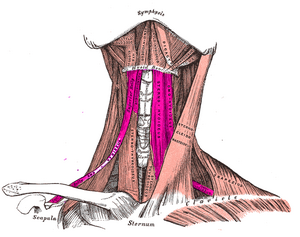Infrahyoid Muscles: Difference between revisions
No edit summary |
Areeba Raja (talk | contribs) No edit summary |
||
| Line 1: | Line 1: | ||
<div class="noeditbox"> ==Page Under Review== This article is currently under review and may not be up to date. Please come back soon to see the finished work! ({{REVISIONDAY}}/{{REVISIONMONTH}}/{{REVISIONYEAR}}) </div> | |||
<div class="editorbox"> '''Original Editor '''- [[User:Manisha Shrestha|Manisha Shrestha]] '''Top Contributors''' - {{Special:Contributors/{{FULLPAGENAME}}}}</div> | <div class="editorbox"> '''Original Editor '''- [[User:Manisha Shrestha|Manisha Shrestha]] '''Top Contributors''' - {{Special:Contributors/{{FULLPAGENAME}}}}</div> | ||
<div class="editorbox"> | <div class="editorbox"> | ||
Revision as of 17:45, 31 January 2022
Original Editor - User Name
Top Contributors - Areeba Raja, Manisha Shrestha and Nupur Smit Shah
Introduction[edit | edit source]
The infrahyoid muscles are a group of four paired muscles that lie inferiorly to the hyoid bone in the anterior aspect of neck. This group of muscles is also known as strap muscles. They connect hyoid, sternum, clavicle and scapula.
Infrahyoid muscles are organised in two layers. Superficial layer consist of sternohyoid and omohyoid whereas deep layer contain sternothyroid and thyrohyoid.
The muscles are involved in movements of the hyoid bone and thyroid cartilage during vocalization, swallowing and mastication.[1]It play an active role in swallowing through the movement of the larynx. They are mainly innervated from the ansa cervicalis.
Sub Heading 3[edit | edit source]
Resources[edit | edit source]
- bulleted list
- x
or
- numbered list
- x
References[edit | edit source]
- ↑ Gray's anatomy : the anatomical basis of clinical practice. 2005. Neck. Muscles.







